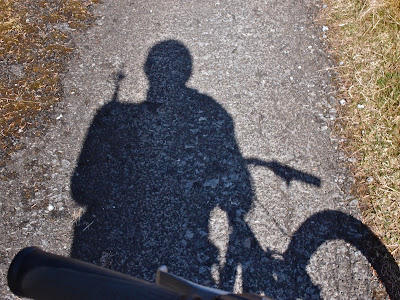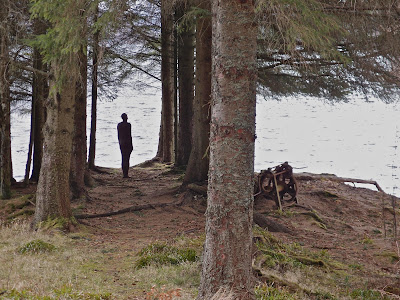 |
| Ben Alder and Beinn Bheoil from Stob an Aonach Mhoir |
 |
| Road to Corrievarkie |
 |
| Uphill shadows |
 |
| Carn Dearg and Sgor Ghaibhre to Ben Alder |
 |
| Loch Ericht and Rannoch from Stob an Aonach Mhoir |
 |
| Loch Ericht and the Fara from Stob an Aonach Mhoir |
 |
| Three cairns on Beinn Mholach |
 |
| Beinn Mholach from Beinn Bhoidheach |
 |
| Schiehallion across Loch Rannoch |
Distance: 22 kilometre cycle, 19 kilometre walk
Time: 6 hours 35 minutes
c Stob an Aonach Mhoir 855m 2hr 2mins
u Glas Mheal Mor 830m 3hrs 15mins
c Beinn Mholach 841m 4hrs 25mins
These two corbetts have been niggling me for the past year, could they be done together and if so from where? It is probably quicker to drive up the A9 and start from Dalnaspidal Lodge but Loch Rannoch is a much more scenic approach and avoids the dreaded A9. The forecasts were showing a brief respite from the showers and wind that have been battering us for the last few days. I was up at 6:30am and away by 7:30am after loading the bike for the two hour drive to Bridge of Ericht at the western end of Loch Rannoch. It was cool but the wind had abated and the blue skies had a whiteness to them which suggested some fickle weather later in the day. I arrived at the Bridge of Ericht surprised to see the gate missing on the private road to Corrievarkie. The man in the adjacent cottage told me there was no problem in parking or cycling up the road which was metalled and a better surface than many local roads.
The gradient was steady although it rises from 200 metres to 600 metres over the 11 kilometres to the start of the walk. The views were ever changing with the white capped hills from Carn Dearg to Ben Alder provided a panorama of many previous adventures. After leaving the forest where a giant steel pipe crossed the river below, there was another gate and then the Loch Ericht dam came into view. After the turn off to the dam the road curves to the right and steepens again but it was all perfectly rideable. I was a bit surprised to find a vehicle parked a couple of kilometres further along. Judging by the gear on the seats, a walker had obviously taken advantage of the open gate and saved themselves a few hours. I abandoned the bike and started the walk at a point just south of Stob an Aonach Mhoir where the road begins its final ascent before dropping to Corrievarkie House.
I figured that I would climb Stob an Aonach Mhoir first whilst the blue skies prevailed and then cut across to Glas Mheal Mor en route for Beinn Mholach. It meant walking another 400 metres or so up the road but then I headed onto the hillside climbing almost due north for the first hill. The ground was boggy and flutes of wet snow slowed progress as each step involved sinking into the wet snow. My goretex running shoes were not much of a defence in these conditions. I watched in awe as a couple of mountain hares, still in their winter whites, accelerated up the hill as I approached. I was thinking that this is good eagle territory. I made for a rock scarp just below the summit and on climbing it came face to face with a golden eagle no more than 30 metres away. It had flown and was several hundred metres away before I retrieved and fired the camera.
The ascent may be a bit of a plod up undistinguished slopes but like all corbetts there is always something good. Here it was the view, one of the very best. Loch Ericht was a rich cobalt blue and across were Beinn Beoil with its splendid corrie yoked together as one with Ben Alder, both hills resplendent in their dazzling white caps. The views up and down Loch Ericht were equally stunning, I loitered for a while, eating an early lunch and rotating my head mesmerised by the views and watching out for the return of the eagle.
The descent was quick and easy. I crossed the road about 800 metres north of where I had left the bike. It was tricky going over the peat hags and burns swollen with snowmelt that made for difficult walking. I headed roughly for the shoulder of Glas Mheal Mor and as I started to climb a herd of 50 or 60 deer scarpered southwards. There was a large snowfield which I tramped through and then, still feeling frisky, I decided to climb the extra 50 metres or so to Glas Mheal Mor. It is the dominant hill from the north west but unclassified in the annals of Scottish hills which are based upon the minimum drop of 150 metre rule rather than any sense of relative importance.
The route across to Beinn Mholach was tedious with lots of peat hags as I traversed under Beinn Bhoidheach. The burns were all covered in snow and crossing them was a game of chance. Finally 200 metres of climbing eastwards to the summit of Beinn Mholach and there seemed no redeeming features. Until reaching the summit, what a magnificent cairn! It is superbly constructed and set next to a forlorn looking trig point with the daddy of all cairns, Schiehallion, looking on from the south east.
If the walk up Beinn Mholach was tedious the descent was worse, I went to the south of Beinn Bhoidheach, which was mistake, and then had to cross 3 kilometres of peat bogs and snow fields to get back to the bike, it seemed interminable. The day had been clouding over and a wind had sprung up from the south west.
The cycle out was mainly downhill but against the wind with several climbs as well. On the descents my eyes were watering and I tried to avoid using the brakes which worked until the bend with the road to the dam when I had to decide between a ditch and the brakes and the brakes won. The last few kilometres flew by helped by some lapwings practising their manoeuvres and peewitting to each other. I hurtled down the final section and despite stops, the ride out had taken only 35minutes. On the journey home I was mesmerised by the views of Loch Rannoch, watched over by the magnificent Schiehallion. It looked like a giant toblerone but maybe I had not taken enough food for the day. It rained as I drove back through Fortingal and along Loch Tay, I had judged the day perfectly.































